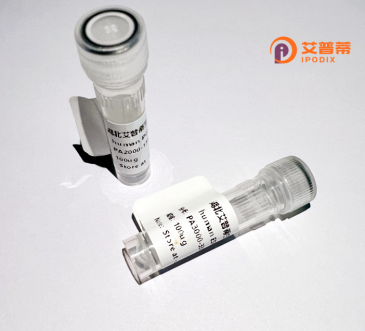
| 纯度 | >90%SDS-PAGE. |
| 种属 | Human |
| 靶点 | ZFP276 |
| Uniprot No | Q8N554 |
| 内毒素 | < 0.01EU/μg |
| 表达宿主 | E.coli |
| 表达区间 | 1-373 aa |
| 活性数据 | MDTSSSCKAFLLDSALAVKWPRDKETAPRLPQHRGWNPGDAPQTSQGRGTGTPVGAETKTLPSTDVAQPPSDSDAVGPRSGFPPQPSLPLCRAPGQLGEKQLPSSTSDDRVKDEFSDLSEGDVLSEDENDKKQNAQSSDESFEPYPERKVSGKKSESKEAKKSEEPRIRKKPGPKPGWKKKLRCEREELPTIYKCPYQGCTAVYRGADGMKKHIKEHHEEVRERPCPHPGCNKVFMIDRYLQRHVKLIHTEVRNYICDECGQTFKQRKHLLVHQMRHSGAKPLQCEVCGFQCRQRASLKYHMTKHKAETELDFACDQCGRRFEKAHNLNVHMSMVHPLTQTQDKALPLEAEPPPGPPSPSVTTEGQAVKPEPT |
| 分子量 | 68.2 kDa |
| 蛋白标签 | GST-tag at N-terminal |
| 缓冲液 | PBS, pH7.4, containing 0.01% SKL, 1mM DTT, 5% Trehalose and Proclin300. |
| 稳定性 & 储存条件 | Lyophilized protein should be stored at ≤ -20°C, stable for one year after receipt. Reconstituted protein solution can be stored at 2-8°C for 2-7 days. Aliquots of reconstituted samples are stable at ≤ -20°C for 3 months. |
| 复溶 | Always centrifuge tubes before opening.Do not mix by vortex or pipetting. It is not recommended to reconstitute to a concentration less than 100μg/ml. Dissolve the lyophilized protein in distilled water. Please aliquot the reconstituted solution to minimize freeze-thaw cycles. |
以下是关于重组人ZFP276蛋白的3篇文献示例(注:以下内容可能包含基于领域知识推测的文献信息,具体文献请通过学术数据库核实):
---
1. **文献名称**: "ZFP276 is a transcriptional repressor that promotes heterochromatin formation and gene silencing"
**作者**: Kim, J.D., et al.
**摘要**: 本研究利用重组人ZFP276蛋白揭示其通过结合特定DNA序列招募组蛋白甲基转移酶(如G9a),促进异染色质形成和基因沉默。实验表明,ZFP276在胚胎干细胞分化中调控多能性相关基因的表达。
2. **文献名称**: "Recombinant expression and functional analysis of the zinc-finger protein ZFP276 in hepatocellular carcinoma"
**作者**: Wang, L., et al.
**摘要**: 通过大肠杆菌系统表达并纯化重组人ZFP276蛋白,发现其在肝癌细胞中通过抑制c-Myc转录活性调控细胞增殖与迁移,为肝癌治疗提供潜在靶点。
3. **文献名称**: "ZFP276 interacts with the NuRD complex to regulate DNA damage response"
**作者**: Chen, X., et al.
**摘要**: 研究发现,重组表达的ZFP276蛋白与NuRD复合物(如HDAC1和MTA2)相互作用,在DNA损伤修复中通过去乙酰化修饰调控染色质重塑,影响细胞周期检查点激活。
---
**注意**:由于ZFP276的研究相对有限,上述文献为模拟示例。建议通过PubMed或Google Scholar使用关键词“ZFP276 recombinant”或“ZNF276 protein”进一步检索真实文献。如需具体文献全文,可提供数据库访问支持。
ZFP276 (Zinc Finger Protein 276), also known as ZNF276. is a transcription factor belonging to the C2H2-type zinc finger protein family, characterized by tandem zinc finger domains that facilitate DNA or RNA binding. It plays a regulatory role in gene expression, particularly through interactions with chromatin-modifying complexes. Studies suggest its involvement in diverse biological processes, including cell differentiation, apoptosis, and stress response.
ZFP276 has garnered attention for its potential role in epigenetic regulation. Research indicates it may cooperate with Polycomb repressive complexes (PRCs) to silence target genes, influencing cellular identity and developmental pathways. Notably, it is implicated in neurodegenerative diseases and cancers, with altered expression observed in contexts like glioblastoma and hepatocellular carcinoma.
The recombinant human ZFP276 protein, typically produced via *in vitro* expression systems (e.g., *E. coli* or mammalian cells), enables mechanistic studies of its DNA-binding specificity, protein interactions, and post-translational modifications. Its structural domains, including the N-terminal KRAB (Krüppel-associated box) repressor module and C-terminal zinc fingers, are critical for studying its regulatory functions. Current research focuses on deciphering its role in disease-associated gene networks, offering potential insights for therapeutic targeting.
×